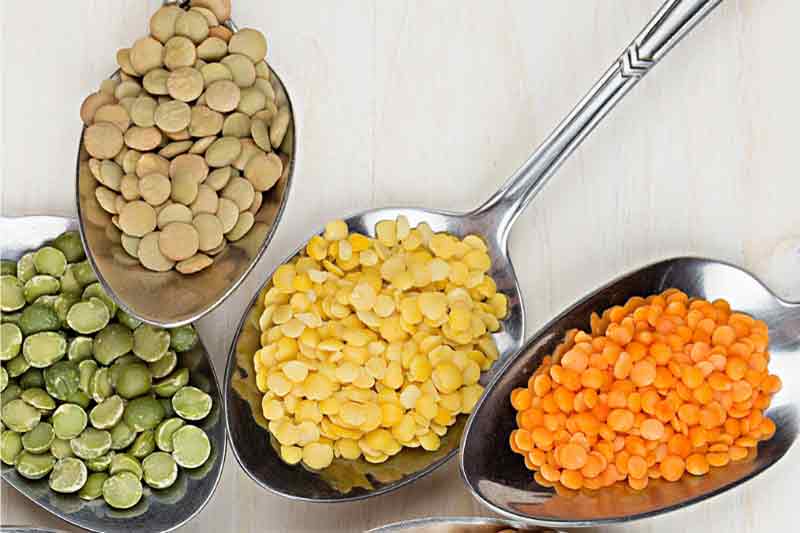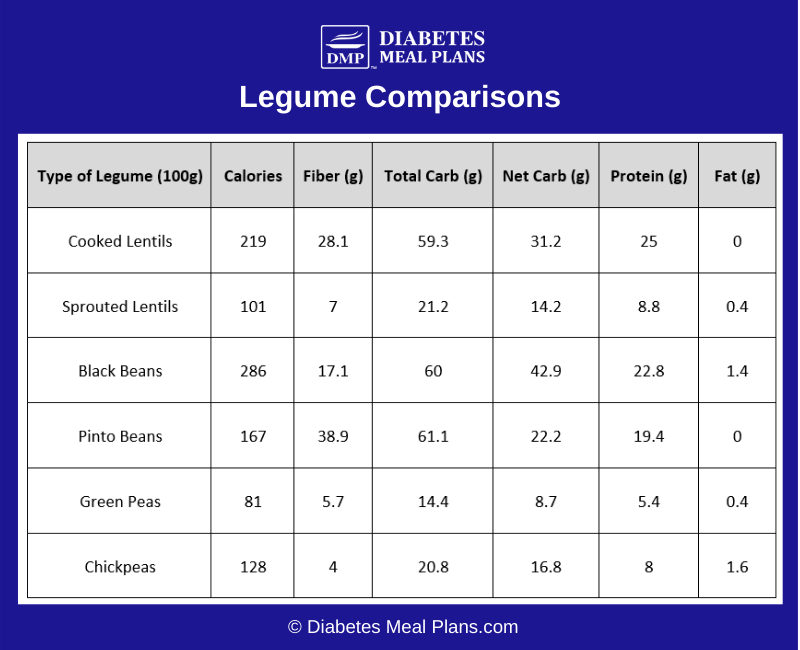Lentils are one of those foods that cause a pretty big stir among the low-carb crowd.
Lentils are high in carbohydrates, but they’re also pretty high in protein and fiber…so, does that make them low-carb friendly or not?
How will eating lentils impact your blood sugar levels and A1c?
Keep reading as we dig into some facts (and dispel some myths) about lentils and type 2 diabetes.

What are Lentils?
Lentils fall under the “legume” family umbrella, but since they are actually considered grain seeds, lentils are also a member of a subgroup of legumes called “pulses.”
While all legumes have some commonalities, pulses like lentils have distinctly different properties than other legumes do.
Lentils come in a variety of colors: red, green, yellow, black, and more! They can be sprouted, cooked, boiled, stewed into soups, or eaten raw.
Most of the lentils on earth are primarily grown in India, Turkey, and Canada because of specific climate requirements.
Lentils are generally considered to be a very healthy food, and they are often revered as a solid protein source for vegetarians and vegans.
Lentil Nutrition Facts
There are 5 big nutritional benefits of legumes:
- High in fiber, especially insoluble fiber, which is good for digestion
- Low glycemic index compared to other carbohydrates, which is better for blood sugar regulation compared to other higher carb foods
- Eating them in small portions may positively effect blood sugar levels (the “second meal effect”)
- Good source of plant protein
- Rich in micronutrients
1/4 cup of red lentils contains these macronutrients:
- Calories: 130
- Protein: 8g
- Total fiber: 5g
- Carbohydrates: 22g
- Sugar: 0g
- Fat: 0g
Red lentils also contain micronutrients like iron, folate, potassium, magnesium, zinc, and vitamin B6.
When you take a look at the list of macronutrients in lentils, you’ll notice that lentils contain way more carbohydrates per serving than we would typically recommend for a low-carb diabetes diet.
So, the big question is: are lentils acceptable on a low carb diet? Does the fiber and protein content make up for the amount of carbs?
We’ll get to answering that question in a moment, but first, let’s see how lentils compare to other legumes in terms of carbs, protein, and fiber.
Comparing Lentils to Other Legumes
It’s no secret that legumes, including lentils, fall more heavily on the side of “carbs” than “protein.” This means that you’ll want to eat lentils sparingly and you’ll want to be mindful of the serving size.
A great goal is to keep your carb intake to less than 25% of your daily energy intake, which typically works out to about 50-80g of carbs per day. Divide that by 3 meals per day and you’ve got a maximum of 15-20g of carbs per meal.
Now, take a glance at the nutrition chart below and you’ll see that a 100g (about 1 cup) serving of most of the legumes listed would put you way over that carb limit.

A 100g serving of cooked lentils (about 1 cup) packs 31.2g of net carbs, so it’s wise to keep your portions much smaller than this. If you choose to eat beans or legumes, a quarter-cup is a reasonable serving size.
The Second Meal Effect: Myth or Truth?
The second meal effect is an occurrence where eating beans and legumes actually stabilizes your blood sugar for many hours after eating.
This may seem odd, given what we know about carbs influencing blood sugar, but it does occur in some people. This effect is most likely due to the high fiber content and the resistant starch found in beans and legumes.
However, the second meal affect is not an excuse to go out and order an XL bean and rice burrito for lunch every day or eat cups of lentils at every meal. This would do way more damage than good in the long run.
While the “second meal effect” is technically truth and not a myth, we still need to leave plenty of room for nuance.
And the good news is there’s still a way to enjoy legumes like lentils without undermining your blood sugar goals.
A smart way to eat lentils is to ignore classic “food-combining” advice that would have you pair a high-carb legume like lentils or beans with another high-carb food like rice.
The point of food-combining is to create a “complete protein” by pairing together foods that don’t already contain all 9 essential amino acids. But unless you’re a vegan or vegetarian, you don’t need to do this, and pairing carbs with carbs is a blood sugar disaster waiting to happen.
To prevent a potential blood sugar spike, eat a small serving of lentils alongside foods that are rich in protein and fat like meat, eggs, or full-fat dairy. This will help mitigate the effect of the carbs, as protein and fat slow down the absorption of glucose.

Research on Lentils and Type 2 Diabetes
In general, research finds that some people who eat diets high in legumes (especially in the context of a Mediterranean diet) may be less likely to develop type 2 diabetes than those who don’t.
This could be due to the fact that people who regularly eat legumes probably eat them along side other vegetables and tend towards a healthier lifestyle in general. Lentils also contain health-boosting antioxidants and polyphenols.
But regardless of why there is a connection between legume intake and disease prevention, we know that prevention is not always the same as treatment.
So, what role to lentils play for those who already have type 2 diabetes?
Well, there have been mixed results about the benefits of eating legumes for people with type 2 diabetes.
A 2015 study examined the effect of a legume-based intervention diet versus a legume-free control diet, for a group of 31 overweight people with type 2 diabetes. In the legume-based diet, two servings of red meat were replaced with various cooked legumes, including lentils, for 3 days per week. After 8 weeks of treatment, they found that the legume-based diet significantly decreased inflammation markers like highly-sensitive C-reactive protein, interleukin-6, and TNF-alpha.
This indicates that lentils may have a positive effect on overall inflammation – although the study didn’t address changes in blood sugar levels or A1c.
Another benefit of lentils is that they have a glycemic index of 35, which puts them squarely into the “low glycemic” category (anything below 55 is considered “low”).
Low GI foods cause a smaller rise in blood sugar levels compared to higher GI foods do, so lentils would be a better choice than, say, potatoes and wheat bread, which have a GI of 78 and 74, respectively.
This sentiment was confirmed in a 2018 study that found that lentil-based food items elicited a much smaller post-prandial (post meal) glucose response than potato-based items did. However, this study was performed on metabolically healthy participants with normal glucose levels, not people with diabetes.
Next, a 2018 study in the Journal of Nutrition found that replacing 50% of a high-carb potato or rice-based meal with lentils lowered the relative post-meal glycemic responses of healthy adults by 20-35%. This showed that adding lentils to a high-carb meal may actually dull a blood sugar spike to some degree.
Observational research suggests that increasing your consumption of pulses (including lentils) could benefit weight control and support a healthier BMI. This may be due to lentils’ slowly digestible carbohydrates, high fiber and high protein contents, and moderate calorie value.
Finally, lentils contain resistant starch, which contributes to the famous “second meal effect.”
What does all this boil down to?
Lentils have some clinically significant benefits due to their fiber content and potential anti-inflammatory effects. However, none of these recent studies showed that consuming lentils lead to a large improvement in blood sugar levels or A1c.
We also know that carbohydrates have the greatest impact on blood sugar and A1c, and lentils are typically quite high in carbs.
Conclusion: The Smartest Way to Enjoy Lentils
So, can people with type 2 diabetes enjoy lentils in their diet?
Lentils are not considered a low carb food, however, most people should be able to add lentils to their low-carb diet without upsetting things too much. Especially where you might be craving carbs – small portions of lentils or beans will be a better option to potatoes or pasta.
The key is to be aware of the serving size you are consuming – only eat small portions or you will see your blood sugar levels soaring.
You also need to be aware of what foods you are eating with the lentils. Focus on adding plenty of protein, fat, and fibrous vegetables to your plate alongside any small portion of lentils or legumes.
And if you’re ever questioning whether or not a specific food is negatively affecting your blood sugar levels, don’t be afraid to test after a meal. Testing your glucose after introducing a new food is a great way to quickly learn which foods are working for your body and which ones aren’t!

Maria Guerra
When you say 1/4 cup serving do you mean dry or cooked lentils? Because 1/4 cup dry ends up being a decent sized serving cooked.
Dr Jedha
Hi Maria, Cooked serving, you can’t eat dry lentils!
BillRVC
Type II Prediabetic using a CGM. I love to make lentil soup but it will spike my glucose over 70 points and keep it elevated for 5 hours. My BG remains higher than normal for most of the next day. For me this is a definite no.
Paul T.
Well written and informative.
Nomana
Very informative article indeed. I learned a lot about the relationship between lentils and type 2 diabetes.
Thank you
Resta Cheng
Excellent article…answered all my questions about lentils!!!